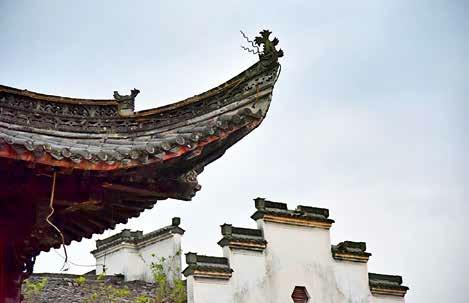A Mountain of Culture
2020-02-04byZhangXingjian
by Zhang Xingjian

I jolted awake at 6:26 a.m. on October 2 this year before my alarm clock even rang and opened my eyes to one of Chinas most charming landscapes through the window: a mountainous region of Huizhou District in Huangshan City, Chinas eastern Anhui Province.
It was drizzling and misty as my parents and I emerged from our room to stroll around historic Huizhous quaint villages with ubiquitous white walled structures, dark gray roof tiles, and graceful upturned eaves.
The weather only enhanced the experience. We felt like we were entering a poetic traditional Chinese ink-wash painting depicting life close to nature as it existed centuries ago.
Most visitors to Huizhou from anywhere in the world would leave with memories of an ancient village shrouded in kitchen smoke, embraced by green hills and clean waters, and dotted with traditional residences featuring washed-out white walls and black roof tiles. It lures everyone into its artistic aura of harmony between human and nature.
The extraordinary views of beautifully designed buildings complementing the equally amazing surroundings provide a solid reason for the Huizhou-style ancient village to be a treasured symbol of Chinese folk culture. While wandering along the village trail, I often wondered what stories the ancient walls could tell if they could talk.
Huizhou District is home to three renowned villages: Xidi, Hongcun, and Huangling. Sandwiched between exquisite homes, stunning ancestral halls, and towering memorial archways, Huizhou-style dwellings from the Ming and Qing dynasties (1368-1911) are plentiful in all three villages. But Huizhou is more than just the three villages. Everyone can find their own special place with a little patience.
To better understand the culture of Huizhou, an old geographical area difficult to pinpoint on contemporary maps, I decided that seeking out a local elder should be my top priority.
Historically, Huizhou was mostly located in southern Anhui Province, but reached into both Jiangxi and Zhejiang provinces. The former Huizhou region was composed of six counties: Shexian, Xiuning, Wuyuan, Qimen, Yixian, and Jixi. Historically, the people of these six counties had high esteem for their cultural identity as Huizhou people after preserving and sharing the same lifestyle for hundreds of years.
The name survived until 1987 when the local government renamed the region Huangshan to promote tourism around Huangshan Mountain (Yellow Mountain), famed for its pine trees and granite peaks.
Locals say that if Huangshan is a thick, profound book, Huizhou culture is its soul. Based on Confucianism, Huizhou culture established a complete system covering various disciplines such as classics, history, philosophy, medicine, science, and art. It cultivated thousands of Huizhou historical celebrities and left over 5,000 historical and cultural relics and more than 1,000 intangible cultural heritage items. It ranks alongside Tibetan culture and Dunhuang culture as one of Chinas three most influential regional cultures.
The rise of regional culture could not have happened without locals wisdom. Huizhou merchants are collectively known as“Huishang” (Hui businesspeople). They are known across China for their diligence, enterprising spirit, honesty, and unique contributions to the countrys economic growth.
Initially, they sold small commodities in the countryside and cities of the ancient land dominated by subsistence agriculture. Gradually, bigger businesses emerged and sprouted sales networks covering the entire country. Huishang also focused on connections with their local communities. When merchants returned home with a fortune, they built mansions, ancestral temples, guild halls, roads, and bridges to expand the influence of their clans. Huishang were not born merchants, but found success thanks to various social factors and painstaking efforts.
Today, the glamor of Huishang lives on thanks to booming rural tourism and photography tourism.
A senior in her 70s, a local called Nanny Zheng, who runs a small hotel, left a deep impression on me. She lives in Shendu Town, Shexian County, Huangshan City. Shendu is home to the Yangchan earth tower cluster, a non-typical example of Huizhou-style architecture that became a popular scenic spot four years ago.
Zheng told me that many moved out of Shendu Town in the 2010s to seek better fortunes because the town was built on cliffs and surrounded by mountains, making its economic expansion in the modern era difficult. Now, the continuous stream of visitors has lured most villagers back to engage in agro-tourism.
While most Chinese were relaxing during the recent weeklong National Day holiday, Nanny Zheng was swamped with the busiest time of the year. She converted her home into a rustic hotel with 10 rooms that can accommodate 25 people in total. The peak travel week brought hordes of city dwellers seeking pastoral pleasures to her hotel.
She told me that both visitors and revenue have surged to nearly double the amount in the same period of last year. “People come here to hear old stories, and I am glad to tell them,” she beamed.“And I am happy to be able to earn a solid income while staying in the place I love.”
Nanny Zhengs story is emblematic of modern Huizhou culture. Huizhou people understand that the regions profound lifestyle was nurtured not only by fairytale scenery, but also by peoples sense of belonging and local cultural heritage.
Entering any village in Huizhou District is a dive into history. Every stone is sated with rich memories. This land where the past and the present meet has nurtured magnificent cultural landscapes to rival its world-class natural scenery.